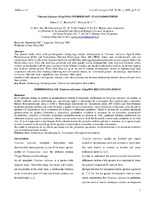Please use this identifier to cite or link to this item:
http://sgc.anlis.gob.ar/handle/123456789/389| DC Field | Value | Language |
|---|---|---|
| dc.contributor.author | Ibáñez, Cecilia I. | es |
| dc.contributor.author | Bozzini, Juan Pablo | es |
| dc.contributor.author | Mariano, Marta | es |
| dc.date.accessioned | 2012-11-22T12:39:55Z | - |
| dc.date.available | 2012-11-22T12:39:55Z | - |
| dc.date.issued | 2009 | - |
| dc.identifier.issn | 0798-4545 | - |
| dc.identifier.uri | http://www.actamicroscopica.org/ | - |
| dc.identifier.uri | http://sgc.anlis.gob.ar/handle/123456789/389 | - |
| dc.description | Fil: Ibáñez, Cecilia I. ANLIS Dr.C.G.Malbrán. Instituto Nacional de Parasitología; Argentina. | es |
| dc.description | Fil: Bozzini, Juan Pablo. ANLIS Dr.C.G.Malbrán. Instituto Nacional de Parasitología; Argentina. | es |
| dc.description | Fil: Mariano, Marta Inés. ANLIS Dr.C.G.Malbrán. Instituto Nacional de Parasitología; Argentina. | es |
| dc.description.abstract | The present works deals with gonadogenesis during egg embryo development in Triatoma infestans. Optical Zeiss Photomicrospe (OM) and Transmition. Electron Microscopy Zeiss 109 (TEM) where used simultaneously, and our observations allow to affirm that between the fourth and fifth day after egg deposition primordial gonads appears before the blastocinesis starts. From the ninth day on female and male gonads can be distinguished, their structural elements; seven ovariols in the females and the same number of testis follicles in males; are clearly established as well as the distinct regions that conform mature gonads. From these days on up to the end of embryo development, sixteen to eighteen days post oviposition and even after hatching following first and second instars, no substantial gonads morphology modification occurs, on the other hand a significant size increase takes place. Germinal cells integration with gonads sketches, their ultra-structure and the inter-relationship between these cell types have been studied. | es |
| dc.format | application/pdf | ES |
| dc.language.iso | en | es |
| dc.relation.ispartof | Acta Microscópica | es |
| dc.rights | Open Access | - |
| dc.rights | Creative Commons Attribution 4.0 International License | - |
| dc.rights.uri | http://creativecommons.org/licenses/by/4.0/ | - |
| dc.source | Acta Microscópica 2009; 18(1): 1-18. | en_US |
| dc.subject | Triatoma | es |
| dc.subject | Embriología | es |
| dc.subject | Triatominae | es |
| dc.subject | Hemípteros | es |
| dc.subject | Reduviidae | es |
| dc.subject | Gónadas | es |
| dc.title | Triatoma infestans (Klug1834)'s Embriology [II] Gonadogenesis | es |
| dc.title.alternative | Embriologia del Triatoma infenstans (Klug1834) [II] Gonadogénesis | es |
| dc.type | Artículo | es |
| anlis.essnrd | 1 | es |
| item.openairetype | Artículo | - |
| item.openairecristype | http://purl.org/coar/resource_type/c_18cf | - |
| item.grantfulltext | open | - |
| item.cerifentitytype | Publications | - |
| item.fulltext | With Fulltext | - |
| item.languageiso639-1 | en | - |
| Appears in Collections: | snrd Publicaciones INP | |
Files in This Item:
| File | Description | Size | Format | |
|---|---|---|---|---|
| ActaMicroscópica,2009,18(1),1-18.pdf | Artículo en inglés | 4.99 MB | Adobe PDF |  View/Open |
Page view(s)
157
checked on Dec 17, 2025
Download(s)
43
checked on Dec 17, 2025
Google ScholarTM
Check
This item is licensed under a Creative Commons License


